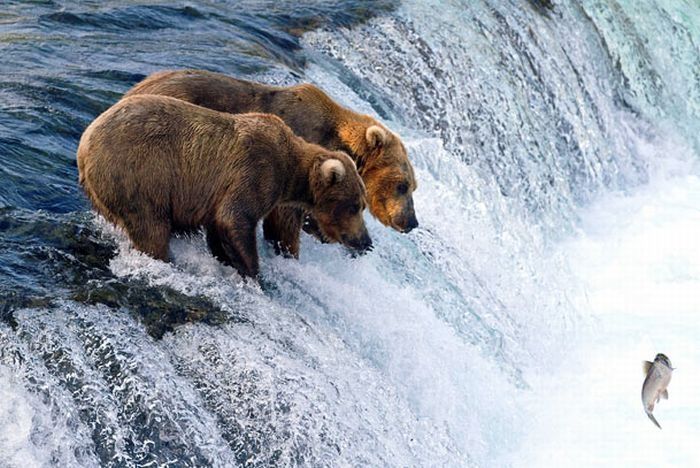|
|
Bears Fishing For Salmon
|
The salmon spend about one to five years (depending on the species) in the open ocean where they become sexually mature. The adult salmon return primarily to their natal stream to spawn. In Alaska, the crossing-over to other streams allows salmon to populate new streams, such as those that emerge as a glacier retreats. The precise method salmon use to navigate has not been established, though their keen sense of smell is involved. Atlantic salmon spend between one and four years at sea. (When a fish returns after just one year's sea feeding it is called a grilse in the UK and Ireland.) Prior to spawning, depending on the species, salmon undergo changes. They may grow a hump, develop canine teeth, develop a kype (curvature of the jaws in male salmon). All will change from the silvery blue of a fresh run fish from the sea to a darker color. Salmon can make amazing journeys, sometimes moving hundreds of miles upstream against strong currents and rapids to reproduce. Chinook and sockeye salmon from central Idaho, for example, travel over 900 miles (1,400 km) and climb nearly 7,000 feet (2,100 m) from the Pacific ocean as they return to spawn. Condition tends to deteriorate the longer the fish remain in fresh water, and they then deteriorate further after they spawn, when they are known as kelts. In all species of Pacific salmon, the mature individuals die within a few days or weeks of spawning, a trait known as semelparity. Between 2% and 4% of Atlantic salmon kelts survive to spawn again, all females. However, even in those species of salmon that may survive to spawn more than once (iteroparity), post-spawning mortality is quite high (perhaps as high as 40 to 50%.)
To lay her roe, the female salmon uses her tail (caudal fin), to create a low-pressure zone, lifting gravel to be swept downstream, excavating a shallow depression, called a redd. The redd may sometimes contain 5,000 eggs covering 30 square feet (2.8 m2). The eggs usually range from orange to red. One or more males will approach the female in her redd, depositing his sperm, or milt, over the roe. The female then covers the eggs by disturbing the gravel at the upstream edge of the depression before moving on to make another redd. The female will make as many as 7 redds before her supply of eggs is exhausted.
|
|









